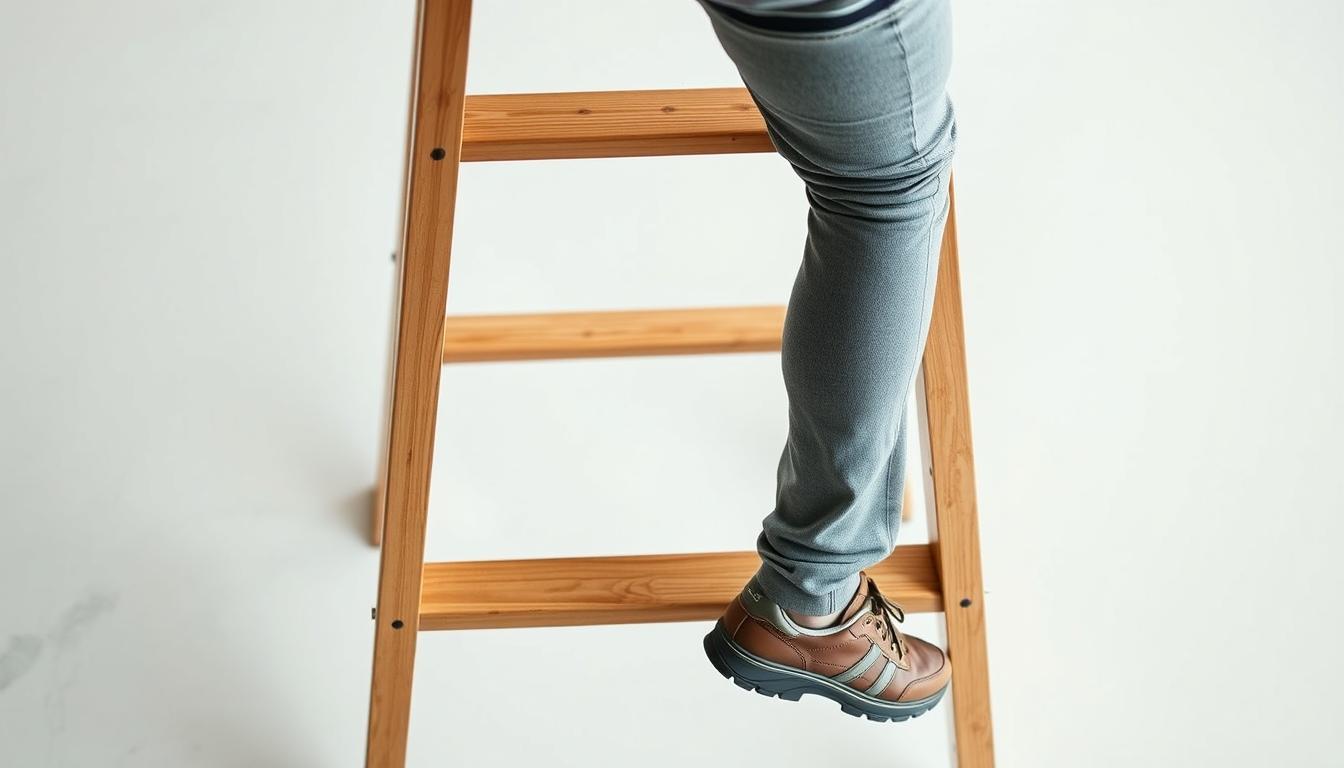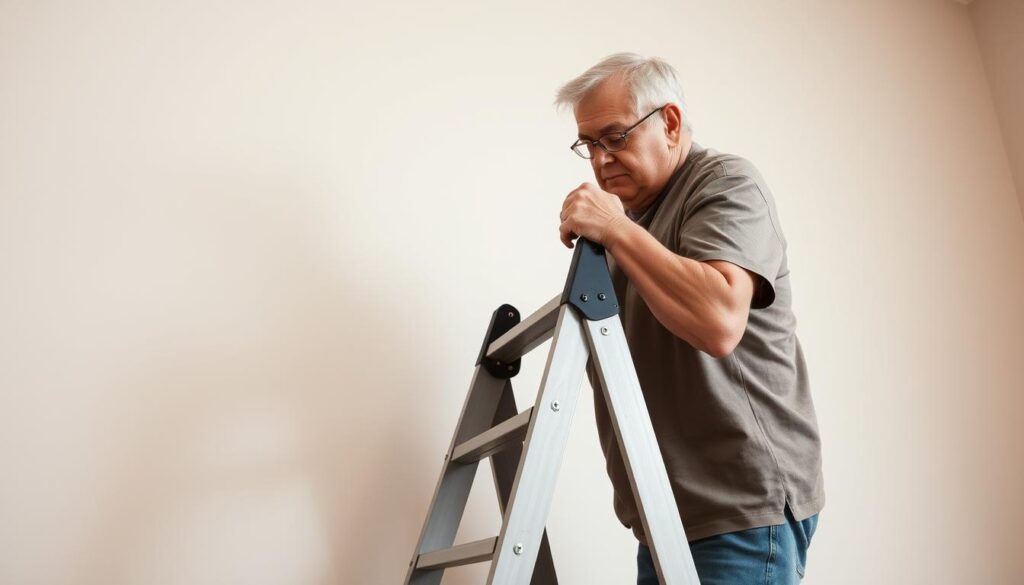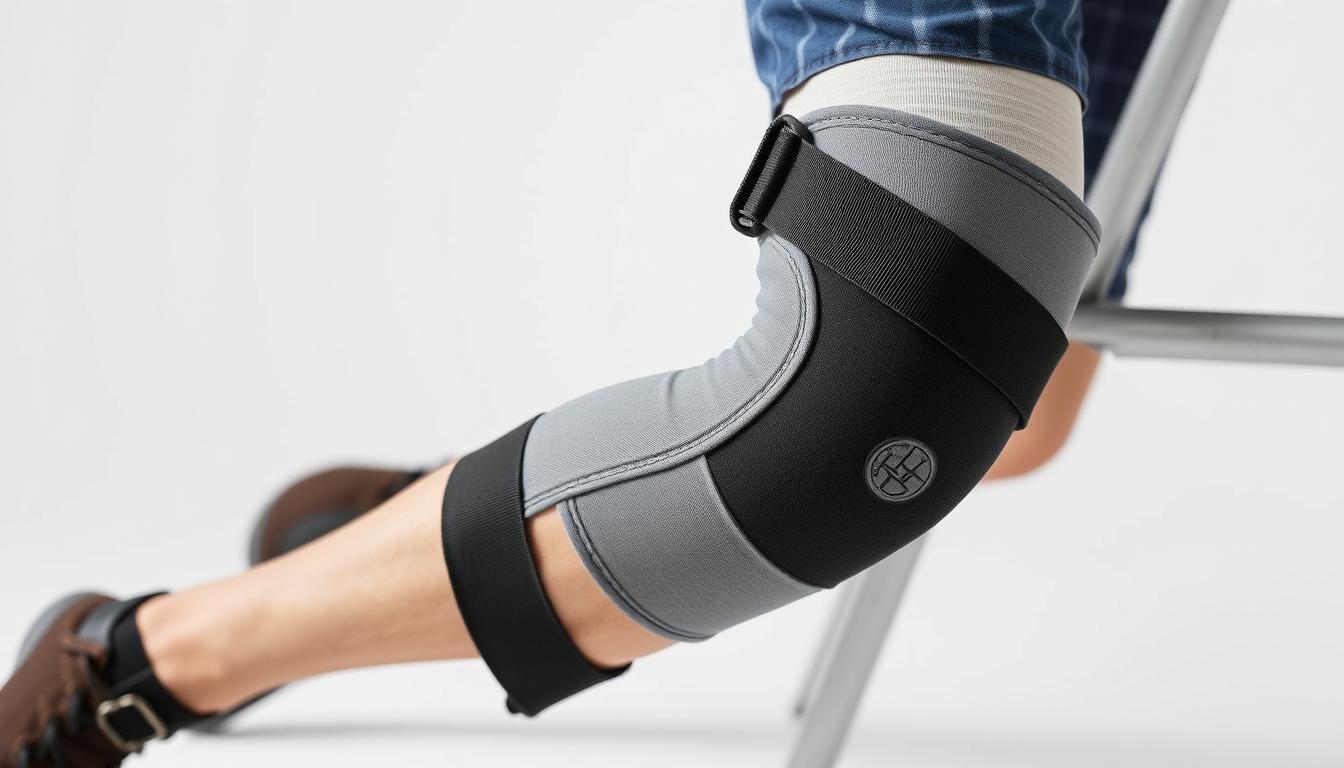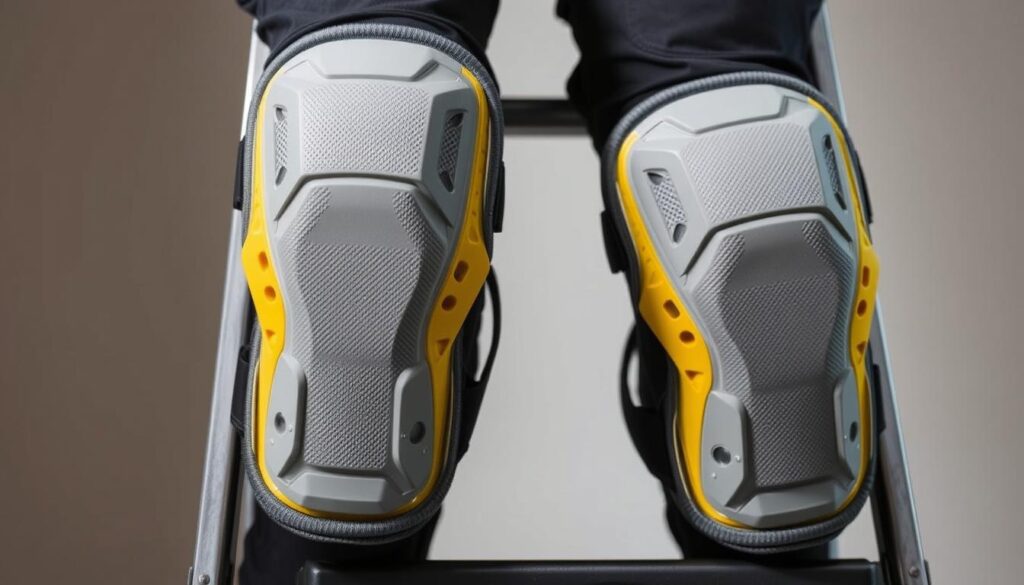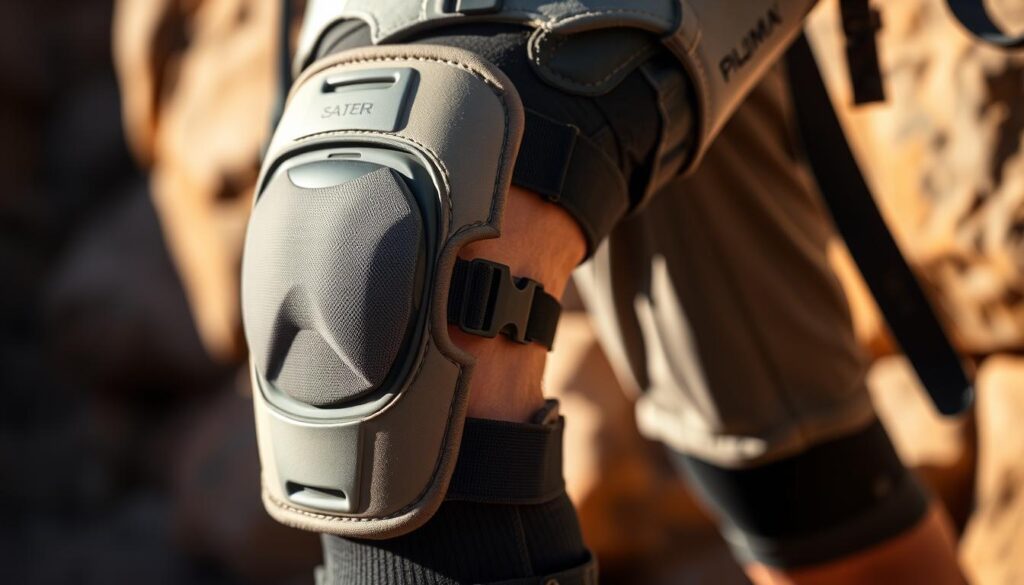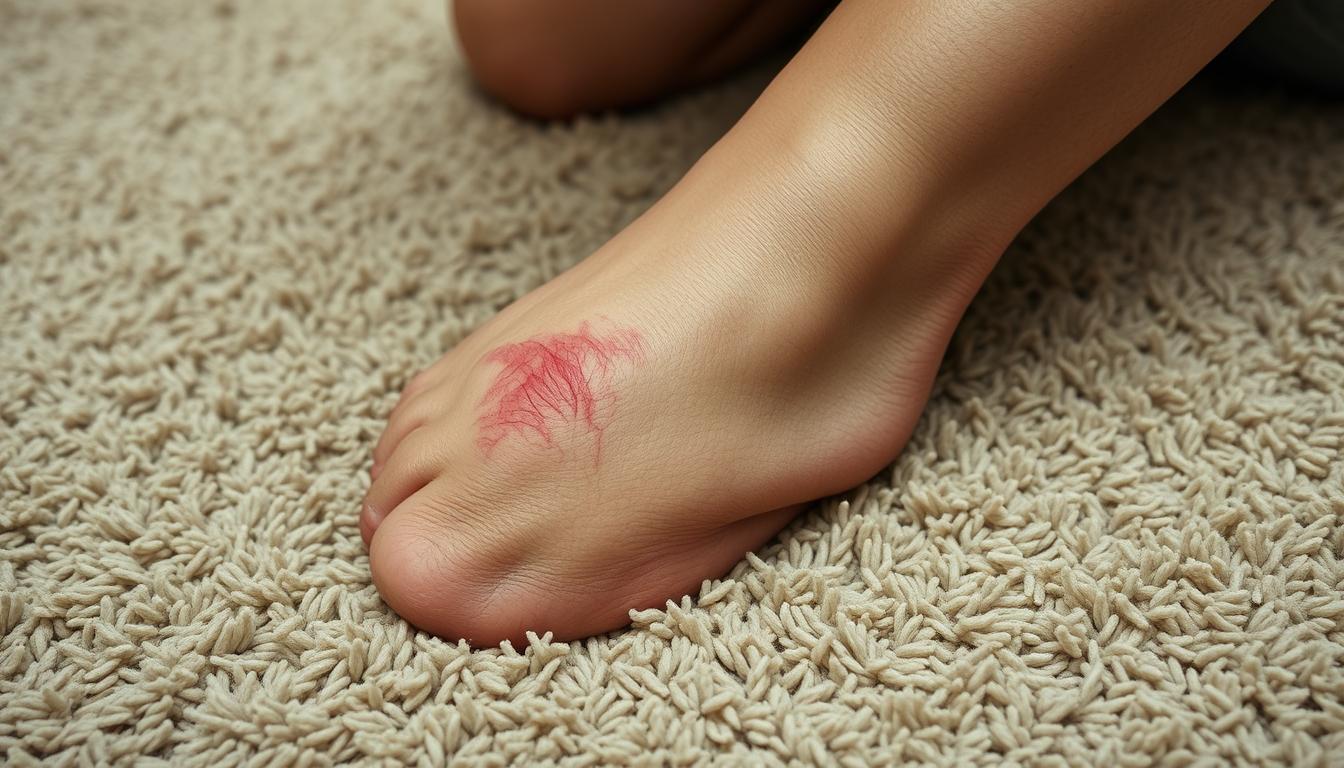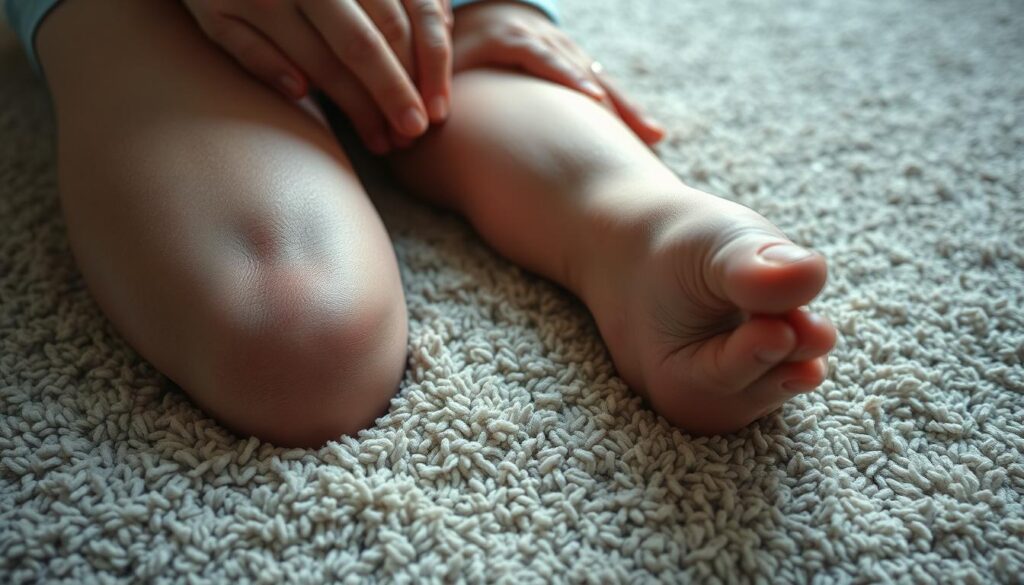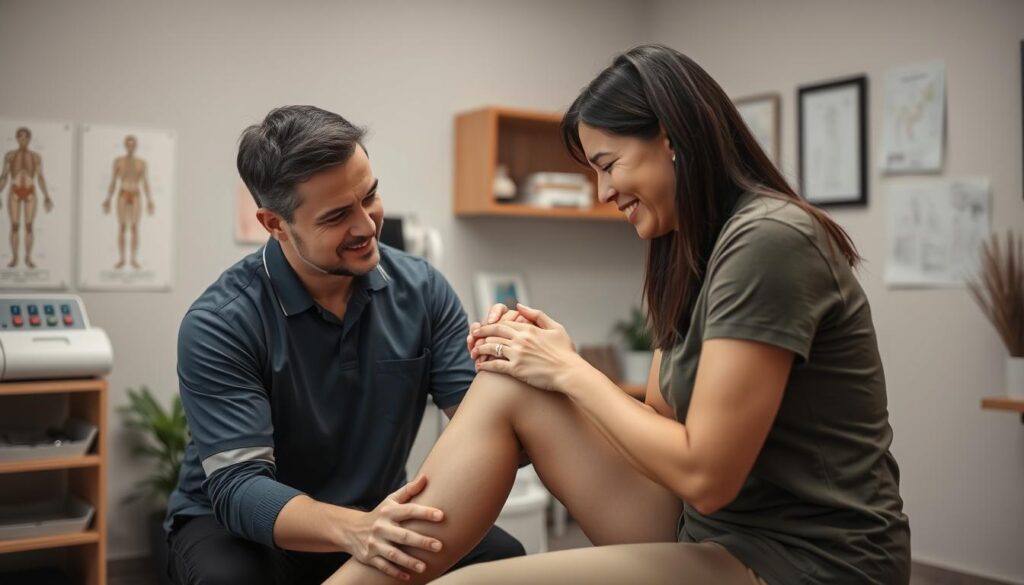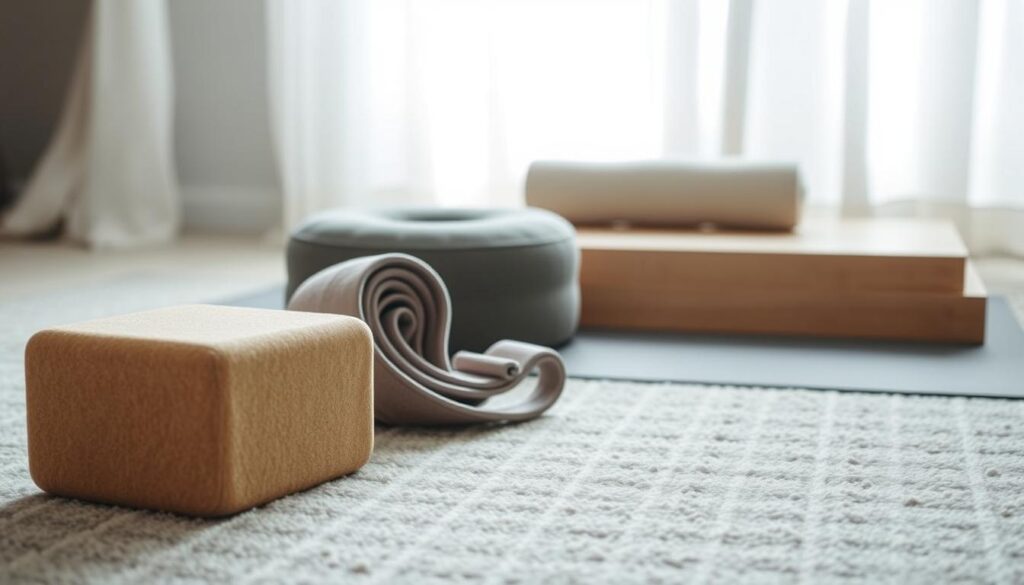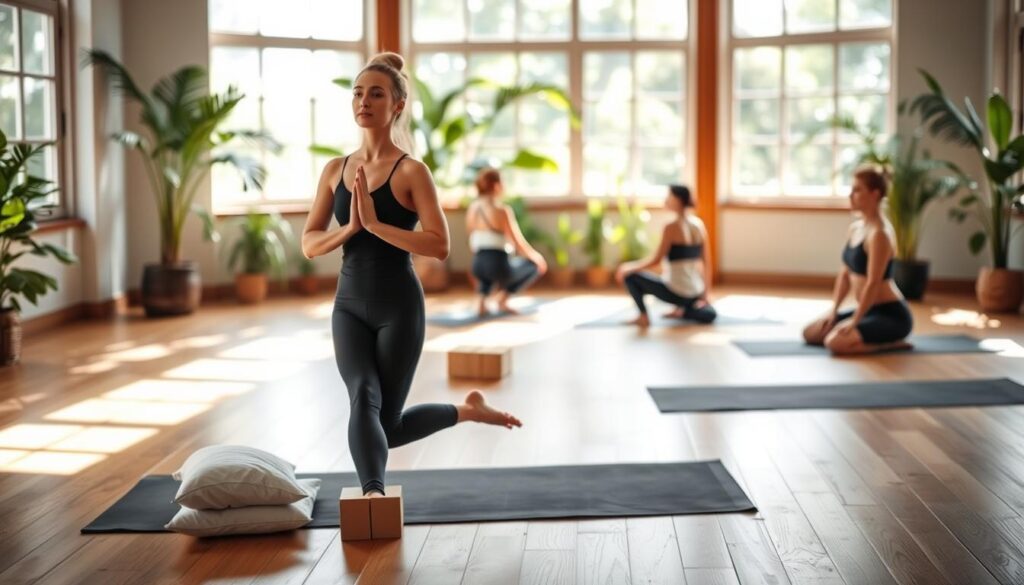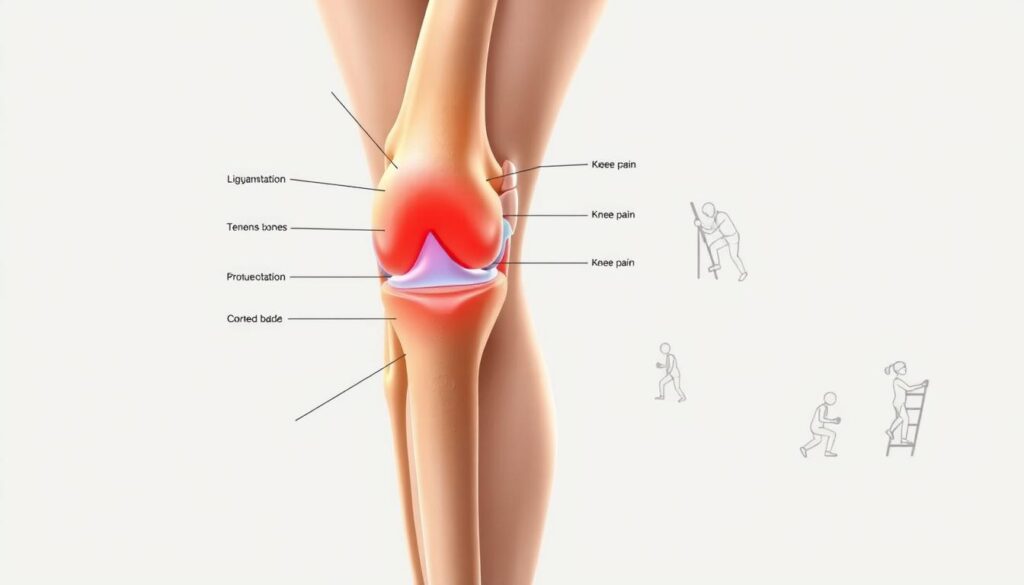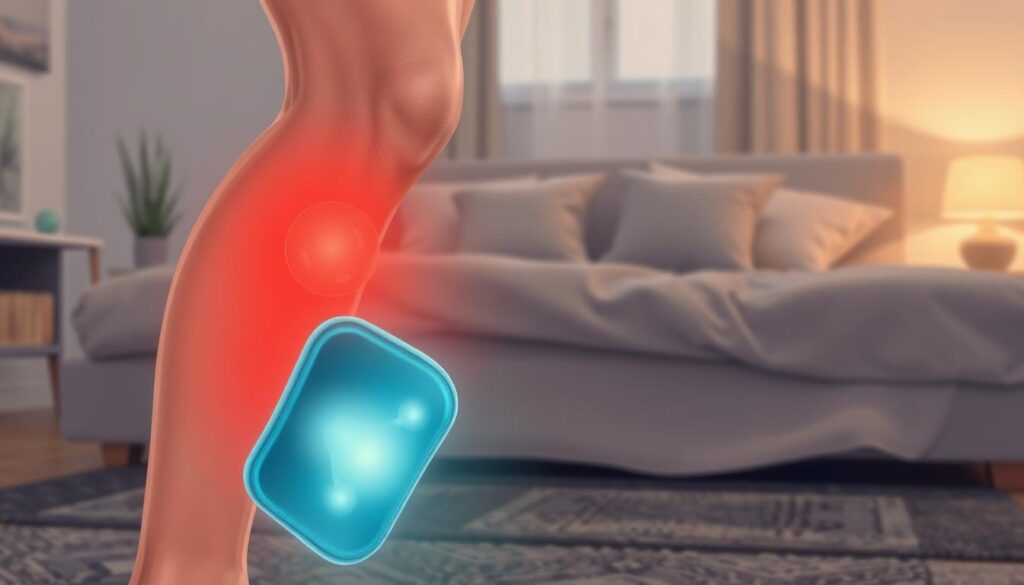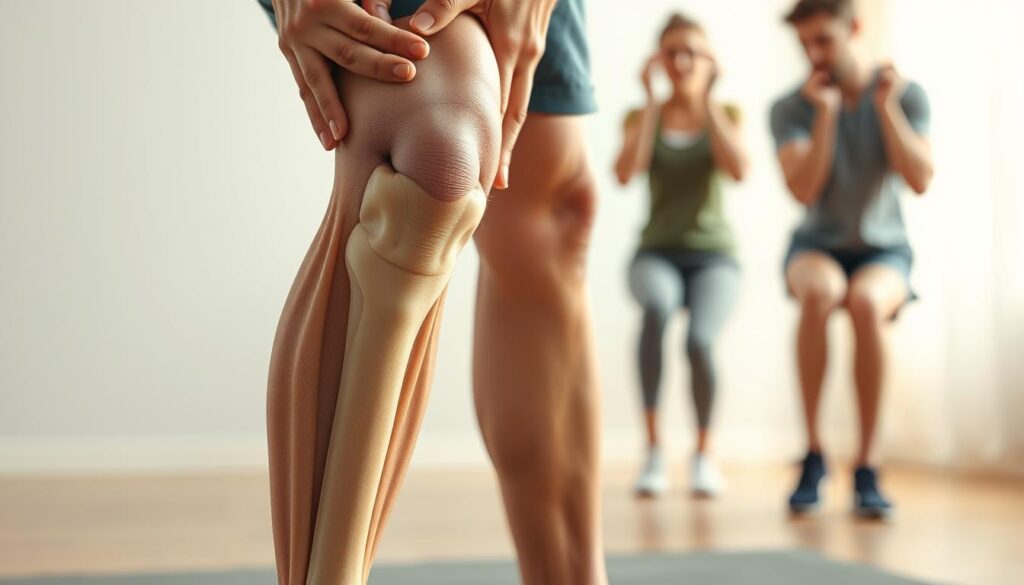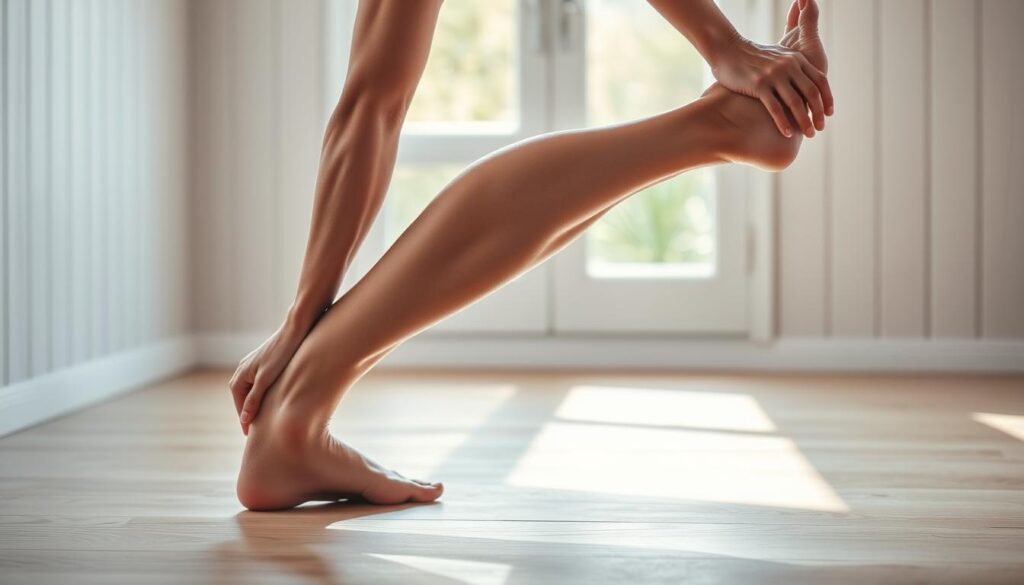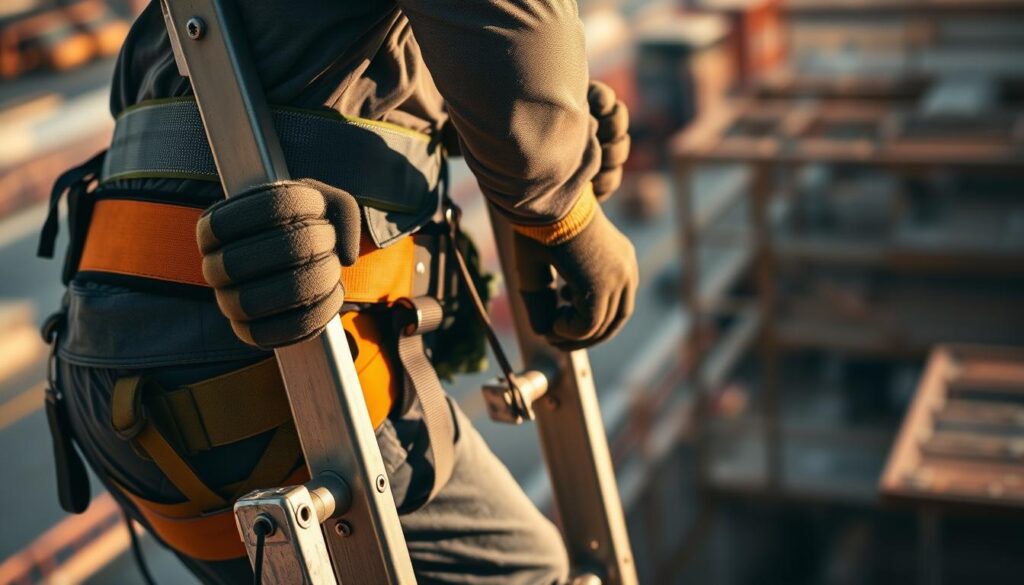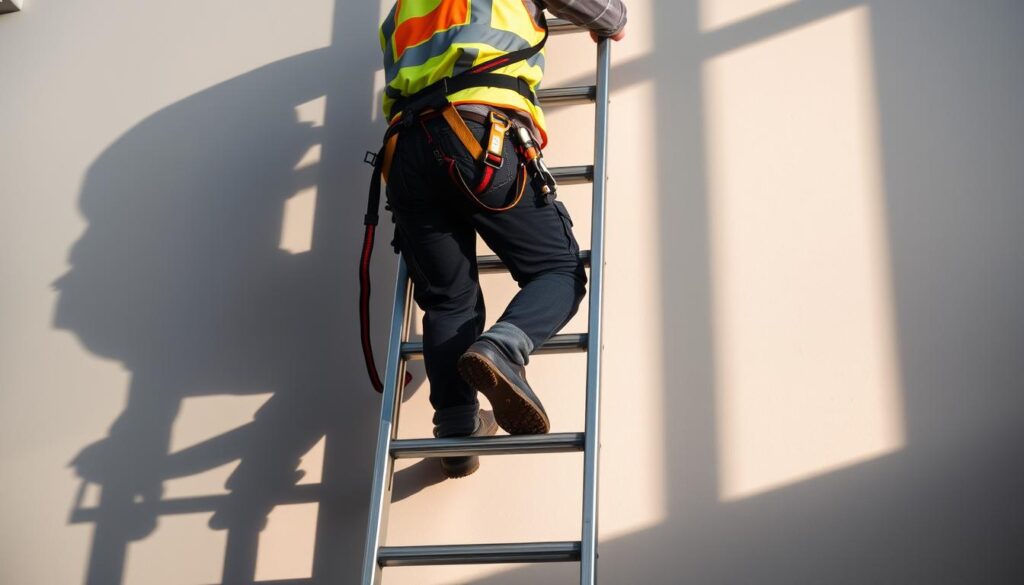Do you struggle with knee pain but still need to climb ladders? Climbing a ladder can be tough, especially with knee issues. We know how important it is to find ladder safety tips for knee pain to prevent making it worse.
We’ll look at the challenges of climbing ladders with knee problems. We’ll also give you a detailed guide on how to do it safely and confidently. By using the right preparation and techniques, you can lower the risk of getting hurt.
Key Takeaways
- Understanding the risks associated with ladder climbing and knee pain
- Precautions to take before climbing a ladder with knee issues
- Proper ladder climbing techniques to minimize knee strain
- Tips for maintaining balance and stability on a ladder
- Best practices for ladder safety with knee problems
Understanding the Challenges of Climbing Ladders with Bad Knees
People with knee problems face special challenges when climbing ladders. The strain from climbing can make knee issues worse. This makes every step a risk.
Climbing ladders needs strength, flexibility, and balance. Knee problems can make these hard to keep. Knowing these challenges helps us find safe ways to climb.
Common Knee Conditions Impacting Ladder Use
Many knee conditions can make ladder climbing hard. These include:
- Arthritis: This causes pain and inflammation in the joints, making steps painful.
- Tendonitis: It’s inflammation of the tendons, causing pain and limiting movement.
- Ligament Sprains: Injuries to the ligaments around the knee, leading to instability and pain.
These conditions make climbing ladders not just hard but also risky if not done carefully.
How Ladder Climbing Affects Knee Health
Climbing ladders puts stress on the knees, including bending and twisting. For those with knee problems, these actions can:
- Make pain and inflammation worse
- Up the risk of more injury
- Limit movement because of pain or fear of injury
Knowing how ladder climbing affects our knees is key. It helps us take precautions and adjust our climbing to reduce risks.
By understanding these challenges and taking steps, we can climb ladders more safely and protect our knees.
Preparing for a Safe Climb

To climb ladders safely with knee problems, we must first assess our overall physical condition and the tools we use. This preparation is crucial for preventing accidents and ensuring a safe climbing experience.
Assessing Our Physical Condition
Before climbing a ladder, it’s essential to evaluate our physical readiness. This involves considering our overall health, strength, and flexibility, particularly in our knees. A thorough self-assessment can help identify potential risks and prevent injuries.
We should ask ourselves a few questions: Are we experiencing any knee pain or discomfort? Are our leg muscles strong enough to support our body weight on the ladder? Have we had any recent injuries or surgeries that could impact our climbing ability?
| Physical Attribute | Relevance to Ladder Climbing | Tips for Improvement |
|---|---|---|
| Knee Strength | Essential for stability and support | Engage in exercises like squats and lunges |
| Flexibility | Important for maintaining balance | Practice stretching exercises regularly |
| Overall Health | Critical for endurance and stamina | Maintain a healthy lifestyle, including a balanced diet and regular exercise |
Choosing the Right Ladder for Our Needs
Selecting the appropriate ladder is vital for safe climbing. The ladder should be tall enough to reach the desired height without standing on the top rung, and it should have a weight capacity that exceeds our body weight.
Key features to consider include:
- Height and reach
- Weight capacity
- Material and durability
- Stability features, such as wide feet or non-slip rungs
Importance of Proper Attire and Footwear
Wearing the right clothing and footwear can significantly impact ladder safety. We should avoid loose clothing that could get caught on the ladder and opt for sturdy, non-slip shoes that provide good traction.
“Safety is not just about avoiding accidents; it’s about creating a culture that prioritizes well-being and precaution.” – Unknown
Proper attire not only enhances our safety but also contributes to our comfort while climbing, reducing strain on our knees.
Essential Ladder Safety Tips

For people with bad knees, climbing ladders can be tough. But, with the right safety tips, you can lower the risk of injury. It’s important to follow key practices to protect your knees while using ladders.
Checking Ladder Stability Before Use
Always check the ladder’s stability before climbing. Make sure it’s on a firm, level surface. Also, ensure all feet are stable and secure.
If the surface is soft or uneven, use ladder levelers or stabilizers. Always inspect the ladder for damage or wear that could affect its stability.
Maintaining Three Points of Contact
It’s key to have three points of contact on the ladder. This means using two hands and one foot, or two feet and one hand. This helps keep your balance and lowers fall risks.
Always face the ladder when climbing up or down. Avoid leaning over the side to reach for something.
Ascending and Descending Techniques
When climbing up or down, do it carefully and deliberately. Take your time and make sure each step is secure before moving. Keep your body centered between the side rails.
Avoid sudden movements that could strain your knees or cause you to lose balance. By following these tips, you can safely climb ladders even with bad knees. It’s all about being aware of your body’s limits and taking the right precautions.
Alternative Techniques for Reducing Knee Strain

For those with knee problems, there are safer ways to climb ladders. We’ll look at some methods to lessen knee strain.
Using a Walking Cane or Crutch
Using a walking cane or crutch can help with knee strain. It spreads the weight and stress, easing the pressure on knees. Make sure the cane or crutch fits right and is sturdy.
The material and durability of the cane or crutch matter a lot. It must hold our weight and any extra forces when climbing. Choosing a strong, adjustable cane or crutch boosts stability.
Opting for Safety Harnesses and Supports
Another option is safety harnesses and supports. They’re great for climbing high ladders or working at heights. Harnesses keep us safe and reduce knee pressure.
It’s key to pick a safety harness that fits well and is made for ladder climbing. Look for ones with padding and adjustable straps for a secure fit. Always follow the maker’s use and care tips.
By using these alternatives, we can lessen knee strain and make climbing safer and easier.
Developing Strength and Flexibility
Exercises that strengthen our knee muscles and improve flexibility can help us climb ladders safely. This is especially true for those with knee problems. It helps lessen the strain from ladder climbing.
Exercises to Strengthen Knee Muscles
It’s important to strengthen the muscles around our knees for safe ladder climbing. We can do this with exercises like:
- Straight leg raises: Lift our leg straight out in front of us, keeping it straight, and then lower it back down.
- Quad sets: Tighten the muscles on the front of our thigh and hold for a few seconds.
- Wall squats: Stand with our back against the wall and slide down into a squat, keeping our knees bent at a 90-degree angle.
These exercises build the strength needed to support our knees while climbing ladders.
Stretching Routines to Improve Flexibility
Improving flexibility is also key. We can do this with stretching routines like:
- Knee flexion stretches: Stand with our feet shoulder-width apart and slowly bend our knees.
- Hamstring stretches: Sit on the floor with our legs straight out in front of us and lean forward, reaching for our toes.
- Calf stretches: Stand facing a wall with one hand on the wall for balance and step back with one foot, keeping our heel on the ground.
Regular stretching improves our range of motion. This makes it easier to climb ladders safely.
By adding these exercises and stretches to our daily routine, we can improve our knee health. This reduces the risk of injury from proper ladder climbing for knee issues. It also lets us use safe ladder climbing techniques for bad knees, making our climbs more secure.
When to Seek Professional Help
Knowing when to get help is key for safe ladder practices, especially with knee problems. Climbing ladders can be tough, and ignoring knee pain can cause bigger injuries.
Recognizing Signs of Injury
It’s important to know when you need medical help. Look out for these signs:
- Persistent pain after climbing
- Swelling or bruising around the knee
- Instability or weakness in the knee
Consulting with a Physical Therapist
Talking to a physical therapist can give you personalized advice. They can create a plan just for you. A physical therapist can help you:
- Develop a strengthening program for your knee muscles
- Improve your flexibility and range of motion
- Learn safe climbing techniques to reduce strain on your knees
Getting professional help when needed makes climbing safer and healthier.
Conclusion: Our Commitment to Safe Ladder Practices
When we climb ladders with bad knees, safety is key. Using safe ladder climbing techniques helps us avoid injuries. This way, we can stay independent and keep doing what we need to do.
We’ve looked at ways to make ladder climbing safer. This includes checking our health, picking the right ladder, and keeping three points of contact. Climbing ladders safely for knee issues means being prepared, using the right techniques, and being careful.
Key Takeaways
To sum up, we’ve talked about getting ready for a safe climb, using methods to lessen knee strain, and building strength and flexibility. By adding these steps to our daily routine, we can climb ladders confidently.
Prioritizing Safety
As we go forward, remember to always put safety first when climbing ladders. This way, you can keep your independence and do tasks easily. With the right knowledge and precautions, you can climb ladders safely.
FAQ
What are some safe ladder climbing techniques for individuals with bad knees?
To climb safely, always keep three points of contact on the ladder. Use the right ladder for your height and needs. This helps avoid knee strain.
How can I reduce knee strain while climbing a ladder?
Try using walking canes or crutches for support. Safety harnesses and supports can also help. They spread out the risk and add security.
What exercises can help strengthen knee muscles for ladder climbing?
Squats, lunges, and leg press are good for your knee muscles. They help improve stability and lower injury risk.
How can I assess my physical condition before climbing a ladder?
Check your overall health before climbing. Look at knee pain, flexibility, and balance. This helps you know if you’re ready.
What are the benefits of consulting with a physical therapist for knee issues?
A physical therapist can give you advice and a plan for your knee problems. They tailor it to your needs for climbing.
What are some common knee conditions that can impact ladder use?
Conditions like arthritis, tendonitis, and ligament sprains can make climbing harder. You might need to use special techniques.
How can I maintain three points of contact while climbing a ladder?
Use two hands and one foot, or two feet and one hand. This keeps you balanced and stable.
What type of ladder is best for individuals with knee problems?
Look for a sturdy ladder with stable feet. A comfortable climbing angle is also important to ease knee strain.
How can I improve my flexibility for ladder climbing?
Add stretching to your daily routine. It boosts flexibility. This makes climbing easier and safer for your knees.
When should I seek professional help for knee injuries?
Get medical help if you have ongoing or severe knee pain, swelling, or instability. These could be signs of a serious injury.
